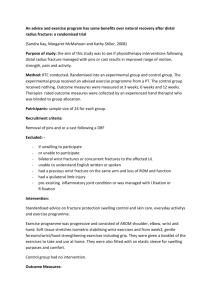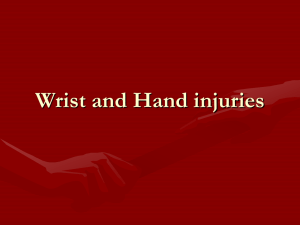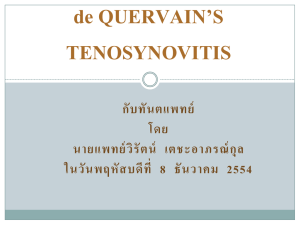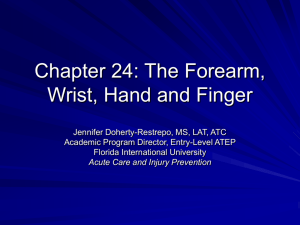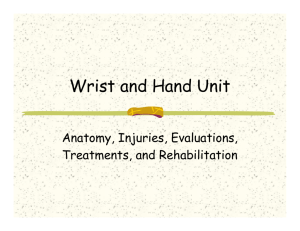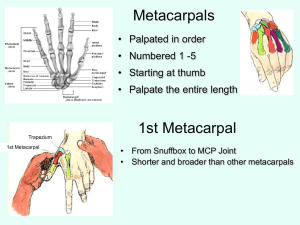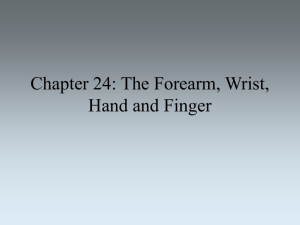Chapter 24 Notes - School City of Hobart
advertisement
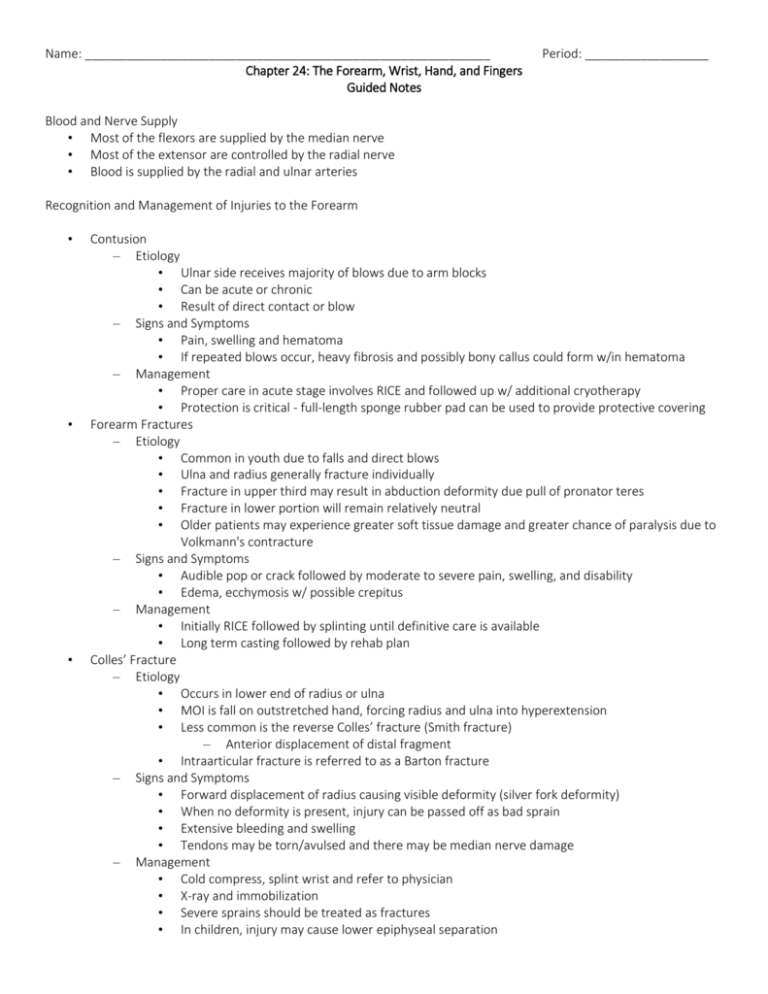
Name: ___________________________________________________________ Chapter 24: The Forearm, Wrist, Hand, and Fingers Guided Notes Period: __________________ Blood and Nerve Supply • Most of the flexors are supplied by the median nerve • Most of the extensor are controlled by the radial nerve • Blood is supplied by the radial and ulnar arteries Recognition and Management of Injuries to the Forearm • • • Contusion – Etiology • Ulnar side receives majority of blows due to arm blocks • Can be acute or chronic • Result of direct contact or blow – Signs and Symptoms • Pain, swelling and hematoma • If repeated blows occur, heavy fibrosis and possibly bony callus could form w/in hematoma – Management • Proper care in acute stage involves RICE and followed up w/ additional cryotherapy • Protection is critical - full-length sponge rubber pad can be used to provide protective covering Forearm Fractures – Etiology • Common in youth due to falls and direct blows • Ulna and radius generally fracture individually • Fracture in upper third may result in abduction deformity due pull of pronator teres • Fracture in lower portion will remain relatively neutral • Older patients may experience greater soft tissue damage and greater chance of paralysis due to Volkmann's contracture – Signs and Symptoms • Audible pop or crack followed by moderate to severe pain, swelling, and disability • Edema, ecchymosis w/ possible crepitus – Management • Initially RICE followed by splinting until definitive care is available • Long term casting followed by rehab plan Colles’ Fracture – Etiology • Occurs in lower end of radius or ulna • MOI is fall on outstretched hand, forcing radius and ulna into hyperextension • Less common is the reverse Colles’ fracture (Smith fracture) – Anterior displacement of distal fragment • Intraarticular fracture is referred to as a Barton fracture – Signs and Symptoms • Forward displacement of radius causing visible deformity (silver fork deformity) • When no deformity is present, injury can be passed off as bad sprain • Extensive bleeding and swelling • Tendons may be torn/avulsed and there may be median nerve damage – Management • Cold compress, splint wrist and refer to physician • X-ray and immobilization • Severe sprains should be treated as fractures • In children, injury may cause lower epiphyseal separation Blood and Nerve Supply • • • • Three major nerves – Ulnar, median and radial Ulnar and radial arteries supply the hand – Two arterial arches (superficial and deep palmar arches) Special Tests – Tinel’s Sign • Produced by tapping over transverse carpal ligament • Tingling, paresthesia over sensory distribution of the median nerve indicates presence of carpal tunnel syndrome – Phalen’s Test • Test for carpal tunnel syndrome • Position is held for approximately one minute • If test is positive, pain will be produced in region of carpal tunnel – Valgus/Varus and Glide Stress Tests • Tests used to assess ligamentous integrity of joints in hands and fingers • Valgus and varus tests are used to test collateral ligaments • Anterior and posterior glides are used to assess the joint capsule – Circulatory and Neurological Evaluation • Hands should be felt for temperature – Cold hands indicate decreased circulation • Pinching fingernails can also help detect circulatory problems (capillary refill) • Allen’s test can also be used – Patient is instructed to clench fist 3-4 times, holding it on the final time – Pressure applied to ulnar and radial arteries – Patient then opens hand (palm should be blanched) – One artery is released and should fill immediately (both should be checked) • Hand’s neurological functioning should also be tested (sensation and motor functioning) Functional Evaluation – Range of motion in all movements of wrist and fingers should be assessed – Active, resistive and passive motions should be assessed and compared bilaterally • Wrist - flexion, extension, radial and ulnar deviation • MCP joint - flexion and extension • PIP and DIP joints - flexion and extension • Fingers - abduction and adduction • MCP, PIP and DIP of thumb - flexion and extension • Thumb - abduction, adduction and opposition • 5th finger - opposition Recognition and Management of Injuries to the Wrist, Hand, and Fingers • Wrist Sprains – Etiology • Most common wrist injury • Arises from any abnormal, forced movement • Falling on hyperextended wrist, violent flexion or torsion • Multiple incidents may disrupt blood supply – Signs and Symptoms • Pain, swelling and difficulty w/ movement – Management • Refer to physician for X-ray if severe • RICE, splint and analgesics • Have patient begin strengthening soon after injury • • • • • • Tape for support can benefit healing and prevent further injury Triangular Fibrocartilage Complex (TFCC) Injury – Etiology • Occurs through forced hyperextension, falling on outstretched hand • Violent twist or torque of the wrist • Often associated w/ sprain of UCL – Signs and Symptoms • Pain along ulnar side of wrist, difficulty w/ wrist extension, possible clicking • Swelling is possible, not much initially • Patient may not report injury immediately – Management • Referred to physician for treatment • Treatment will require immobilization initially for 4 weeks • Immobilization should be followed by period of strengthening and ROM activities • Surgical intervention may be required if conservative treatments fail Tendinitis – Etiology • Repetitive pulling movements of (commonly) flexor carpi radialis and ulnaris; repetitive pressure on palms (cycling) can cause irritation of flexor digitorum • Primary cause is overuse of the wrist – Signs and Symptoms • Pain on active use or passive stretching • Isometric resistance to involved tendon produces pain, weakness or both – Management • Acute pain and inflammation treated w/ ice massage 4x daily for first 48-72 hours, NSAID’s and rest • When swelling has subsided, ROM is promoted w/ contrast bath • PRE can be instituted once swelling and pain subsided (high rep, low resistance) Carpal Tunnel Syndrome – Etiology • Compression of median nerve due to inflammation of tendons and sheaths of carpal tunnel • Result of repeated wrist flexion or direct trauma to anterior aspect of wrist – Signs and Symptoms • Sensory and motor deficits (tingling, numbness and paresthesia); weakness in thumb – Management • Conservative treatment - rest, immobilization, NSAID’s • If symptoms persist, corticosteroid injection may be necessary or surgical decompression of transverse carpal ligament Dislocation of Lunate Bone – Etiology • Forceful hyperextension or fall on outstretched hand – Signs and Symptoms • Pain, swelling, and difficulty executing wrist and finger flexion • Numbness/paralysis of flexor muscles due to pressure on median nerve – Management • Treat as acute, and sent to physician for reduction • If not recognized, bone deterioration could occur, requiring surgical removal • Usual recovery is 1-2 months Scaphoid Fracture – Etiology • Caused by force on outstretched hand, compressing scaphoid between radius and second row of carpal bones • Often fails to heal due to poor blood supply – • • • • Signs and Symptoms • Swelling, severe pain in anatomical snuff box • Presents like wrist sprain • Pain w/ radial flexion – Management • Must be splinted and referred for X-ray prior to casting • Immobilization lasts 6 weeks and is followed by strengthening and protective tape • Wrist requires protection against impact loading for 3 additional months Wrist Ganglion – Etiology • Synovial cyst (herniation of joint capsule or synovial sheath of tendon) • Generally appears following wrist strain – Signs and Symptoms • Appear on back of wrist generally • Occasional pain w/ lump at site • Pain increases w/ use • May feel soft, rubbery or very hard – Management • Old method was to first break down the swelling through distal pressure and then apply pressure pad to encourage healing • New approach includes aspiration, chemical cauterization w/ subsequent pressure from pad • Ultrasound can be used to reduce size • Surgical removal is most effective treatment method Extensor Tendon Avulsion (Mallet Finger) – Etiology • Caused by a blow to tip of finger avulsing extensor tendon from insertion • Also referred to as baseball or basketball finger – Signs and Symptoms • Pain at DIP; X-ray shows avulsed bone on dorsal proximal distal phalanx • Unable to extend distal end of finger (carrying at 30 degree angle) • Point tenderness at sight of injury – Management • RICE and splinting for 6-8 weeks Boutonniere Deformity – Etiology • Rupture of extensor expansion dorsal to the middle phalanx • Tendon slides below axis of PIP joint Forces DIP joint into extension and PIP into flexion – Signs and Symptoms • Severe pain, obvious deformity and inability to extend DIP joint • Swelling, point tenderness – Management • Cold application, followed by splinting • Splinting must be continued for 5-8 weeks • Athlete is encouraged to flex distal phalanx Flexor Digitorum Profundus Rupture (Jersey Finger) – Etiology • Rupture of flexor digitorum profundus tendon from insertion on distal phalanx • Often occurs w/ ring finger when athlete tries to grab a jersey – • • • • • Signs and Symptoms • DIP can not be flexed, finger remains extended • Pain and point tenderness over distal phalanx – Management • Must be surgically repaired • Rehab requires 12 weeks and there is often poor gliding of tendon, w/ possibility of re-rupture Gamekeeper’s Thumb – Etiology • Sprain of UCL of MCP joint of the thumb • Mechanism is forceful abduction of proximal phalanx occasionally combined w/ hyperextension – Signs and Symptoms • Pain over UCL in addition to weak and painful pinch – Management • Immediate follow-up must occur • If instability exists, athlete should be referred to orthopedist • If stable, X-ray should be performed to rule out fracture • Thumb splint should be applied for protection for 3 weeks or until pain free • Splint should extend from wrist to end of thumb in neutral position • Thumb spica should be used following splinting for support • If a complete tear occurs, surgical repair is necessary to allow normal function to return Swan Neck Deformity and PsuedoBoutonniere Deformity – Etiology • Distal tear of volar plate may cause Swan Neck deformity; proximal tear may cause PsuedoBoutonniere deformity – Signs and Symptoms • Pain, swelling w/ varying degrees of hyperextension • Tenderness over volar plate of PIP • Indication of volar plate tear = passive hyperextension – Management • RICE and analgesics • Splint in 20-30 degrees of flexion for 3 weeks; followed by buddy taping and then PRE Metacarpal Fracture – Etiology • Direct axial force or compressive force • Fractures of the 5th metacarpal are associated w/ boxing or martial arts (boxer’s fracture) – Signs and Symptoms • Pain and swelling; possible angular or rotational deformity – Management • RICE, analgesics are given followed by X-ray examinations • Deformity is reduced, followed by splinting - 4 weeks of splinting after which ROM is carried out Bennett’s Fracture – Etiology • Occurs at carpometacarpal joint of the thumb as a result of an axial and abduction force to the thumb – Signs and Symptoms • CMC may appeared to be deformed - X-ray will indicate fracture • Patient will complain of pain and swelling over the base of the thumb – Management • Structurally unstable and must be referred to an orthopedic surgeon Fingernail Deformities – Changes in normal appearance of the fingernail can be indicative of a number of different diseases • Scaling or ridging = psoriasis • Ridging and poor development = nutritional deficiencies • • Clubbing and cyanosis = congenital heart disorders or chronic respiratory disease Spooning or depression = thyroid problems, iron deficiency anemia Rehabilitation of the Forearm, Wrist, Hand, and Fingers • • • • • • General Body Conditioning – Must maintain pre-injury level of conditioning – Cardiorespiratory, strength, flexibility and neuromuscular control – Many exercise options (particularly lower extremity) Joint Mobilizations – Wrist and hand respond to traction and mobilization techniques Flexibility – Full pain free ROM is a major goal of rehabilitation – The program should include active assisted and active pain free stretching Strength – Exercises should not aggravate condition or disrupt healing process – A variety of exercises are available for strength (wrist and hand) Neuromuscular Control – Hand and fingers require restoration of dexterity • Pinching, fine motor activities (buttoning buttons, tying shoes, and picking up small objects) – It is important to incorporate functional activities designed to restore patient’s ability to perform daily activities Return to Activity – Grip strength must be equal bilaterally, full range of motion and dexterity – Thumb has unique strength requirements – A variety of customizable bracing and splinting devices are available to protect injured wrist and hand
